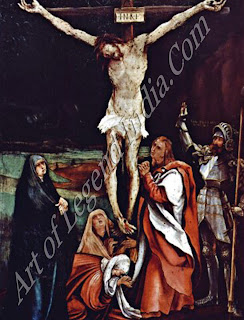
This is Grunewald's earliest depiction of the crucified Christ a subject he was to make his own. Longinus was the name given to the Roman centurion present at the Crucifixion who exclaimed (in the words of the inscription next to him) 'Vere fillius del erat ille' 'Truly this man was the son of God'. The gloomy landscape contributes much to the painting's mood.
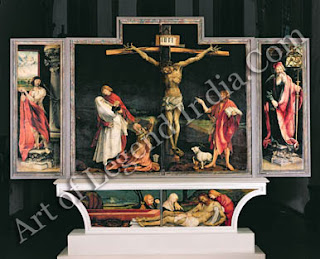
The Crucifixion that forms the centerpiece of the Isenheim Altarpiece is one of the most unforgettable images in the whole of Western javascript:void(0);art. No previous portrayal of the subject had so mercilessly depicted the ghastliness of Christ's physical sufferings. The calm figure of St John is the perfect foil to the convulsed and mangled body on the cross. The predella which accompanied this aspect of the altarpiece shows the Entombment of Christ, its quiet grief contrasting with the anguish of the Crucifixion.
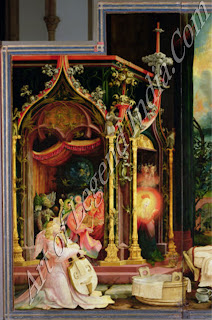
This panel and The Virgin and Child (opposite) form a pair when the altar is first opened. The Virgin thus appears twice, looking out from the bizarre chapel towards herself and her son. Grunewald's extraordinarily vivid imagination comes out in the vegetable-like forms of the architecture and the characterization of the rejoicing angels as well as in the brilliant lighting effects.
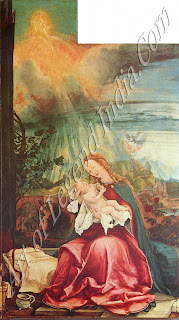
In this scene Grunewald combines the homely (most evident in the detail of the chamber pot) with the sublime. Behind the Virgin and Child the Annunciation to the Shepherds takes place, the angels appearing in a flood of light from heaven, where God the Father sits resplendently enthroned. The roses were flowers particularly associated with the Virgin, who was known as a 'rose without thorns'.
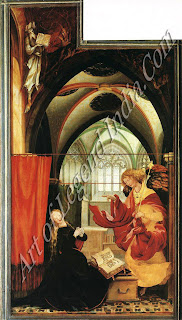
As is common in scenes of the Annunciation, the Virgin's book is open at the passage from the Book of Isaiah in the Old Testament foretelling her divine favour Ecce virgo concipiet et pariet filium (Behold a virgin shall conceive and bear a son). Isaiah himself is represented at top left with his book of prophecies. There is a similarity in the poses of the Virgin and the angel here and the Virgin and St John in the Crucifixion, even though the mood is quite different.

This is the supreme example of Grunewald's mastery of light. The triumphant Christ ascends to Heaven in a blaze of glory, his spirituality all the more ethereal in comparison with the heavy and earthbound figures of the soldiers around his tomb below. Although Christ displays the nail and lance wounds, the horrible lacerations of his body have disappeared a reminder to the sufferers at the hospital that they too could be cleansed of their diseases and sins.
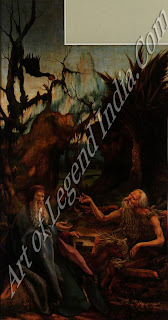
St Anthony was the patron saint of the Hospital Order. According to legend, he made a journey at the age of 90 to meet another hermit, St Paul, who was then 113. They were brought bread by a raven. The coat of arms on the stone on which St Anthony sits is that of Guido. Guersi, Preceptor of the Order and Grunewald may well have used his features for the face of St Anthony. It is also widely accepted that St Paul is a self-portrait of Grunewald.
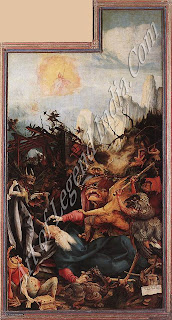
This subject gave artists an opportunity to let their imaginations run riot in the creation of monstrous demons, and Griinewald responded with tremendous gusto. Once again the theme of healing is apparent. The piece of paper at the right says, in translation, 'Where were you, good Jesus, where were you? Why did you not help me and heal my wounds?' Christ, in fact, is there, in the sky, responding to the saint's plea and dispatching his angels to fight off the demons.

Grunewald painted this picture for a new collegiate church in Halle built by Cardinal Albrecht of Brandenburg. Erasmus (on the left) and Maurice (in armour) were the joint patron saints of the church, but they have no connection in history or legend. Grunewald therefore makes of the scene a splendid piece of pageantry.

This panel was originally painted on the back with a picture of Christ Carrying the Cross, but it was sawn apart in the 19th century so both images could be displayed. In his last representation of the Crucifixion, Grunewald has made the figure of Christ even more huge and dominating.
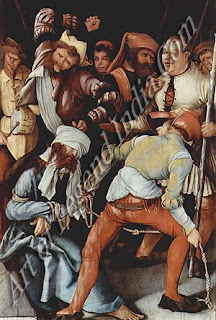 This painting is usually accepted as Grunewald's first surviving work. The date 1503 was on an inscription on the painting that came off during cleaning, but this probably refers to the death of the sister of Grunewald’s patron, which it commemorates, rather than to the date of the painting itself. The elaboration of the costume is unusual for Grunewald (whose figures are usually in 'timeless' dress), but it does not detract from the brutal power of the scene.
This painting is usually accepted as Grunewald's first surviving work. The date 1503 was on an inscription on the painting that came off during cleaning, but this probably refers to the death of the sister of Grunewald’s patron, which it commemorates, rather than to the date of the painting itself. The elaboration of the costume is unusual for Grunewald (whose figures are usually in 'timeless' dress), but it does not detract from the brutal power of the scene.  This is Grunewald's earliest depiction of the crucified Christ a subject he was to make his own. Longinus was the name given to the Roman centurion present at the Crucifixion who exclaimed (in the words of the inscription next to him) 'Vere fillius del erat ille' 'Truly this man was the son of God'. The gloomy landscape contributes much to the painting's mood.
This is Grunewald's earliest depiction of the crucified Christ a subject he was to make his own. Longinus was the name given to the Roman centurion present at the Crucifixion who exclaimed (in the words of the inscription next to him) 'Vere fillius del erat ille' 'Truly this man was the son of God'. The gloomy landscape contributes much to the painting's mood.  The Crucifixion that forms the centerpiece of the Isenheim Altarpiece is one of the most unforgettable images in the whole of Western javascript:void(0);art. No previous portrayal of the subject had so mercilessly depicted the ghastliness of Christ's physical sufferings. The calm figure of St John is the perfect foil to the convulsed and mangled body on the cross. The predella which accompanied this aspect of the altarpiece shows the Entombment of Christ, its quiet grief contrasting with the anguish of the Crucifixion.
The Crucifixion that forms the centerpiece of the Isenheim Altarpiece is one of the most unforgettable images in the whole of Western javascript:void(0);art. No previous portrayal of the subject had so mercilessly depicted the ghastliness of Christ's physical sufferings. The calm figure of St John is the perfect foil to the convulsed and mangled body on the cross. The predella which accompanied this aspect of the altarpiece shows the Entombment of Christ, its quiet grief contrasting with the anguish of the Crucifixion. This panel and The Virgin and Child (opposite) form a pair when the altar is first opened. The Virgin thus appears twice, looking out from the bizarre chapel towards herself and her son. Grunewald's extraordinarily vivid imagination comes out in the vegetable-like forms of the architecture and the characterization of the rejoicing angels as well as in the brilliant lighting effects.
This panel and The Virgin and Child (opposite) form a pair when the altar is first opened. The Virgin thus appears twice, looking out from the bizarre chapel towards herself and her son. Grunewald's extraordinarily vivid imagination comes out in the vegetable-like forms of the architecture and the characterization of the rejoicing angels as well as in the brilliant lighting effects. In this scene Grunewald combines the homely (most evident in the detail of the chamber pot) with the sublime. Behind the Virgin and Child the Annunciation to the Shepherds takes place, the angels appearing in a flood of light from heaven, where God the Father sits resplendently enthroned. The roses were flowers particularly associated with the Virgin, who was known as a 'rose without thorns'.
In this scene Grunewald combines the homely (most evident in the detail of the chamber pot) with the sublime. Behind the Virgin and Child the Annunciation to the Shepherds takes place, the angels appearing in a flood of light from heaven, where God the Father sits resplendently enthroned. The roses were flowers particularly associated with the Virgin, who was known as a 'rose without thorns'. As is common in scenes of the Annunciation, the Virgin's book is open at the passage from the Book of Isaiah in the Old Testament foretelling her divine favour Ecce virgo concipiet et pariet filium (Behold a virgin shall conceive and bear a son). Isaiah himself is represented at top left with his book of prophecies. There is a similarity in the poses of the Virgin and the angel here and the Virgin and St John in the Crucifixion, even though the mood is quite different.
As is common in scenes of the Annunciation, the Virgin's book is open at the passage from the Book of Isaiah in the Old Testament foretelling her divine favour Ecce virgo concipiet et pariet filium (Behold a virgin shall conceive and bear a son). Isaiah himself is represented at top left with his book of prophecies. There is a similarity in the poses of the Virgin and the angel here and the Virgin and St John in the Crucifixion, even though the mood is quite different. This is the supreme example of Grunewald's mastery of light. The triumphant Christ ascends to Heaven in a blaze of glory, his spirituality all the more ethereal in comparison with the heavy and earthbound figures of the soldiers around his tomb below. Although Christ displays the nail and lance wounds, the horrible lacerations of his body have disappeared a reminder to the sufferers at the hospital that they too could be cleansed of their diseases and sins.
This is the supreme example of Grunewald's mastery of light. The triumphant Christ ascends to Heaven in a blaze of glory, his spirituality all the more ethereal in comparison with the heavy and earthbound figures of the soldiers around his tomb below. Although Christ displays the nail and lance wounds, the horrible lacerations of his body have disappeared a reminder to the sufferers at the hospital that they too could be cleansed of their diseases and sins. St Anthony was the patron saint of the Hospital Order. According to legend, he made a journey at the age of 90 to meet another hermit, St Paul, who was then 113. They were brought bread by a raven. The coat of arms on the stone on which St Anthony sits is that of Guido. Guersi, Preceptor of the Order and Grunewald may well have used his features for the face of St Anthony. It is also widely accepted that St Paul is a self-portrait of Grunewald.
St Anthony was the patron saint of the Hospital Order. According to legend, he made a journey at the age of 90 to meet another hermit, St Paul, who was then 113. They were brought bread by a raven. The coat of arms on the stone on which St Anthony sits is that of Guido. Guersi, Preceptor of the Order and Grunewald may well have used his features for the face of St Anthony. It is also widely accepted that St Paul is a self-portrait of Grunewald. This subject gave artists an opportunity to let their imaginations run riot in the creation of monstrous demons, and Griinewald responded with tremendous gusto. Once again the theme of healing is apparent. The piece of paper at the right says, in translation, 'Where were you, good Jesus, where were you? Why did you not help me and heal my wounds?' Christ, in fact, is there, in the sky, responding to the saint's plea and dispatching his angels to fight off the demons.
This subject gave artists an opportunity to let their imaginations run riot in the creation of monstrous demons, and Griinewald responded with tremendous gusto. Once again the theme of healing is apparent. The piece of paper at the right says, in translation, 'Where were you, good Jesus, where were you? Why did you not help me and heal my wounds?' Christ, in fact, is there, in the sky, responding to the saint's plea and dispatching his angels to fight off the demons. Grunewald painted this picture for a new collegiate church in Halle built by Cardinal Albrecht of Brandenburg. Erasmus (on the left) and Maurice (in armour) were the joint patron saints of the church, but they have no connection in history or legend. Grunewald therefore makes of the scene a splendid piece of pageantry.
Grunewald painted this picture for a new collegiate church in Halle built by Cardinal Albrecht of Brandenburg. Erasmus (on the left) and Maurice (in armour) were the joint patron saints of the church, but they have no connection in history or legend. Grunewald therefore makes of the scene a splendid piece of pageantry.  This panel was originally painted on the back with a picture of Christ Carrying the Cross, but it was sawn apart in the 19th century so both images could be displayed. In his last representation of the Crucifixion, Grunewald has made the figure of Christ even more huge and dominating.
This panel was originally painted on the back with a picture of Christ Carrying the Cross, but it was sawn apart in the 19th century so both images could be displayed. In his last representation of the Crucifixion, Grunewald has made the figure of Christ even more huge and dominating.
0 Response to "Painting Gallery of Mathis Grunewald "
Post a Comment